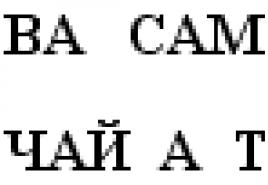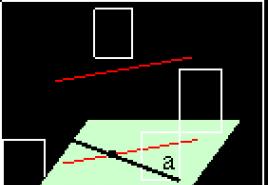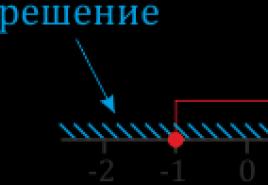Irrational inequalities. Theory and examples
In this lesson we will consider the solution of irrational inequalities, we will give various examples.
Topic: Equations and Inequalities. Systems of equations and inequalities
Lesson:Irrational inequalities
When solving irrational inequalities, it is often necessary to raise both sides of the inequality to some degree, this is a rather important operation. Let us recall the features.
Both sides of the inequality can be squared if both of them are non-negative, only then we get the correct inequality from the true inequality.
Both sides of the inequality can be cube in any case, if the original inequality was true, then when we cube, we get the correct inequality.
Consider an inequality of the form:
The radical expression must be non-negative. The function can take on any values, there are two cases to consider.

In the first case, both sides of the inequality are non-negative, we have the right to square. In the second case, the right-hand side is negative, and we have no right to square. In this case, it is necessary to look at the meaning of inequality: here a positive expression (square root) is greater than a negative expression, which means that inequality is always satisfied.
So, we have the following solution scheme:

In the first system, we do not protect the radical expression separately, since when the second inequality of the system is satisfied, the radical expression must automatically be positive.
Example 1 - Solve Inequality:
![]()
According to the scheme, we pass to an equivalent set of two systems of inequalities:

Let's illustrate:
Fig. 1 - illustration of the solution of example 1
As we can see, when getting rid of irrationality, for example, when squaring, we get a set of systems. Sometimes this complex design can be simplified. In the resulting set, we have the right to simplify the first system and get an equivalent set:

As an independent exercise, it is necessary to prove the equivalence of these populations.
Consider an inequality of the form:
Similar to the previous inequality, we consider two cases:

In the first case, both sides of the inequality are non-negative, we have the right to square. In the second case, the right-hand side is negative, and we have no right to square. In this case, it is necessary to look at the meaning of inequality: here a positive expression (square root) is less than a negative expression, which means that inequality is contradictory. There is no need to consider the second system.
We have an equivalent system:

Sometimes an irrational inequality can be solved graphically. This method is applicable when the corresponding graphs can be easily built and their intersection points can be found.
Example 2 - Solve inequalities graphically:
but) ![]()
b) ![]()
We have already solved the first inequality and we know the answer.
To solve inequalities graphically, you need to plot the function on the left side and the function on the right side.

Fig. 2. Graphs of functions and
To plot the function graph, it is necessary to transform the parabola into a parabola (mirror it about the y-axis), shift the resulting curve by 7 units to the right. The graph confirms that this function decreases monotonically in its domain of definition.
The function graph is a straight line, it is easy to plot it. The y-intercept is (0; -1).
The first function decreases monotonically, the second increases monotonically. If the equation has a root, then it is the only one, it is easy to guess from the graph:.
When the argument is less than the root, the parabola is above the straight line. When the argument is between three and seven, the line is above the parabola.
We have the answer:
An effective method for solving irrational inequalities is the method of intervals.
Example 3 - Solve inequalities using the interval method:
but) ![]()
b) ![]()
according to the method of intervals, it is necessary to temporarily move away from inequality. To do this, transfer everything in the given inequality to the left side (get zero on the right) and introduce a function equal to the left side:
![]()
now it is necessary to examine the resulting function.
ODZ: ![]()
We have already solved this equation graphically, so we do not dwell on determining the root.
Now it is necessary to select intervals of constancy and determine the sign of the function at each interval:

Fig. 3. Intervals of constancy for example 3
Recall that to determine the signs on an interval, it is necessary to take a sample point and substitute it into the function; the resulting sign will be retained by the function throughout the entire interval.
Let's check the value at the boundary point:
![]()
The obvious answer is:
Consider the following type of inequality:
![]()
First, we write down the ODZ:
The roots exist, they are non-negative, we can square both parts. We get:
We got an equivalent system:

The resulting system can be simplified. When the second and third inequalities are satisfied, the first is automatically true. We have: ![]()
Example 4 - Solve Inequality:
![]()
We act according to the scheme - we get an equivalent system.
Your privacy is important to us. For this reason, we have developed a Privacy Policy that describes how we use and store your information. Please read our privacy policy and let us know if you have any questions.
Collection and use of personal information
Personal information refers to data that can be used to identify a specific person or contact him.
You may be asked to provide your personal information at any time when you contact us.
Below are some examples of the types of personal information we may collect and how we may use such information.
What personal information we collect:
- When you leave a request on the site, we may collect various information, including your name, phone number, email address, etc.
How we use your personal information:
- The personal information we collect allows us to contact you and report unique offers, promotions and other events and upcoming events.
- From time to time, we may use your personal information to send important notifications and messages.
- We may also use personal information for internal purposes, such as conducting audits, data analysis and various research in order to improve the services we provide and provide you with recommendations regarding our services.
- If you participate in a prize draw, competition, or similar promotional event, we may use the information you provide to administer such programs.
Disclosure of information to third parties
We do not disclose information received from you to third parties.
Exceptions:
- If it is necessary - in accordance with the law, court order, in court proceedings, and / or on the basis of public requests or requests from government authorities on the territory of the Russian Federation - to disclose your personal information. We may also disclose information about you if we determine that such disclosure is necessary or appropriate for security, law enforcement, or other socially important reasons.
- In the event of a reorganization, merger or sale, we may transfer the personal information we collect to the appropriate third party - the legal successor.
Protection of personal information
We take precautions - including administrative, technical and physical - to protect your personal information from loss, theft, and abuse, as well as from unauthorized access, disclosure, alteration and destruction.
Respect for your privacy at the company level
In order to make sure that your personal information is safe, we bring the rules of confidentiality and security to our employees, and strictly monitor the implementation of confidentiality measures.
Any inequality that includes a function under the root is called irrational... There are two types of such inequalities:
In the first case, the root is smaller than the function g (x), in the second, it is larger. If g (x) - constant, inequality is drastically simplified. Please note: outwardly, these inequalities are very similar, but their solution schemes are fundamentally different.
Today we will learn how to solve irrational inequalities of the first type - they are the simplest and most understandable. The inequality sign can be strict or non-strict. The following statement is true for them:
Theorem. Any irrational inequality of the form
Equivalent to the system of inequalities:
Not weak? Let's take a look at where such a system comes from:
- f (x) ≤ g 2 (x) - everything is clear here. This is the original squared inequality;
- f (x) ≥ 0 is the ODZ of the root. Let me remind you: the arithmetic square root exists only from non-negative numbers;
- g (x) ≥ 0 is the range of the root. By squaring inequality, we burn the cons. As a result, extra roots may arise. The inequality g (x) ≥ 0 cuts them off.
Many students "get stuck" on the first inequality of the system: f (x) ≤ g 2 (x) - and completely forget the other two. The result is predictable: wrong decision, lost points.
Since irrational inequalities are a rather complex topic, we will analyze 4 examples at once. From elementary to really complex. All tasks are taken from the entrance exams of the Moscow State University. M.V. Lomonosov.
Examples of problem solving
A task. Solve the inequality:
Before us is the classic irrational inequality: f (x) = 2x + 3; g (x) = 2 is a constant. We have:
Of the three inequalities, only two remain by the end of the solution. Because the inequality 2 ≥ 0 always holds. We intersect the remaining inequalities:

So, x ∈ [−1,5; 0.5]. All dots are filled because inequalities are not strict.
A task. Solve the inequality:
We apply the theorem:
We solve the first inequality. To do this, we open the square of the difference. We have:
2x 2 - 18x + 16< (x
− 4) 2 ;
2x 2 - 18x + 16< x
2 − 8x
+ 16:
x 2 - 10x< 0;
x (x - 10)< 0;
x ∈ (0; 10).
Now let's solve the second inequality. There too square trinomial:
2x 2 - 18x + 16 ≥ 0;
x 2 - 9x + 8 ≥ 0;
(x - 8) (x - 1) ≥ 0;
x ∈ (−∞; 1] ∪∪∪∪)








